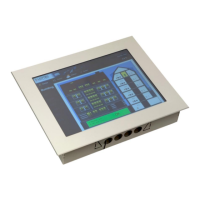L-VIS User Manual 301 LOYTEC
Version 6.2 LOYTEC electronics GmbH
15.7.3.2 Ambiguity
If a regular expression could match two different parts of the input string, it will match the
one which begins earliest. If both begin in the same place but match different lengths, or
match the same length in different ways, life gets messier, as follows.
In general, the possibilities in a list of branches are considered in left-to-right order, the
possibilities for *, +, and ? are considered longest-first, nested constructs are considered
from the outermost in, and concatenated constructs are considered leftmost-first. The match
that will be chosen is the one that uses the earliest possibility in the first choice that has to
be made.
If there is more than one choice, the next will be made in the same manner (earliest
possibility) subject to the decision on the first choice, and so forth.
For example, (ab|a)b*c could match abc in one of two ways. The first choice is
between ab and a; since ab is earlier, and does lead to a successful overall match, it is
chosen. Since the b is already spoken for, the b* must match its last possibility -- the
empty string -- since it must respect the earlier choice. In the particular case where no |
operators are present and there is only one *, +, or ?, the net effect is that the longest
possible match will be chosen. So ab*, presented with xabbbby, will match abbbb. Note
that if ab* is tried against xabyabbbz, it will match ab just after x, due to the begins-
earliest rule. In effect, the decision on where to start the match is the first choice to be
made; hence subsequent choices must respect it even if this leads them to less-preferred
alternatives.
15.8 External Storage
Some L-Vis devices are equipped with a micro SD card slot and/or USB host ports to
connect external storage media. Once the memory device is connected, it can be managed
via the web page of the device. The section Config->Removable Media contains all options
to mount and eject memory devices, allocate swap space, or write a backup of the internal
trend data to the external memory. Note that allocating or removing swap space will require
a reboot of the device to take effect.
The built-in setup menu of the device contains a page called Storage which provides
buttons to save and restore complete device backups or project files, and to copy internal
trend data to the external memory. These buttons will automatically mount the media if
needed, execute the command, and eject the media again if it was mounted automatically
(not already mounted manually before).
New storage media normally comes preformatted and is suitable for immediate use with L-
Vis devices and PCs running the Windows operating system. If the media needs to be
formatted manually, create one primary partition and format it using standard settings. L-
Vis will mount the first primary partition found on the media.

